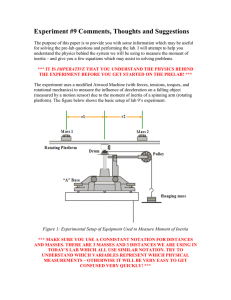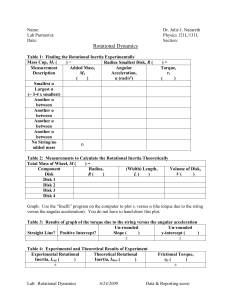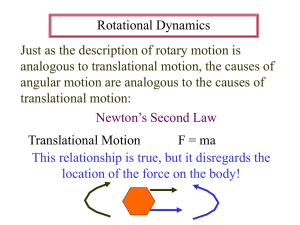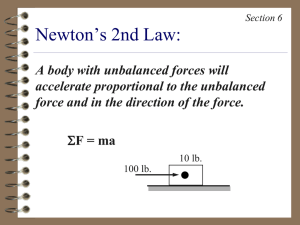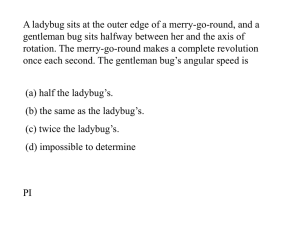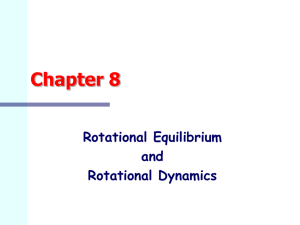During the execution of the experiment, it will be necessary to
advertisement
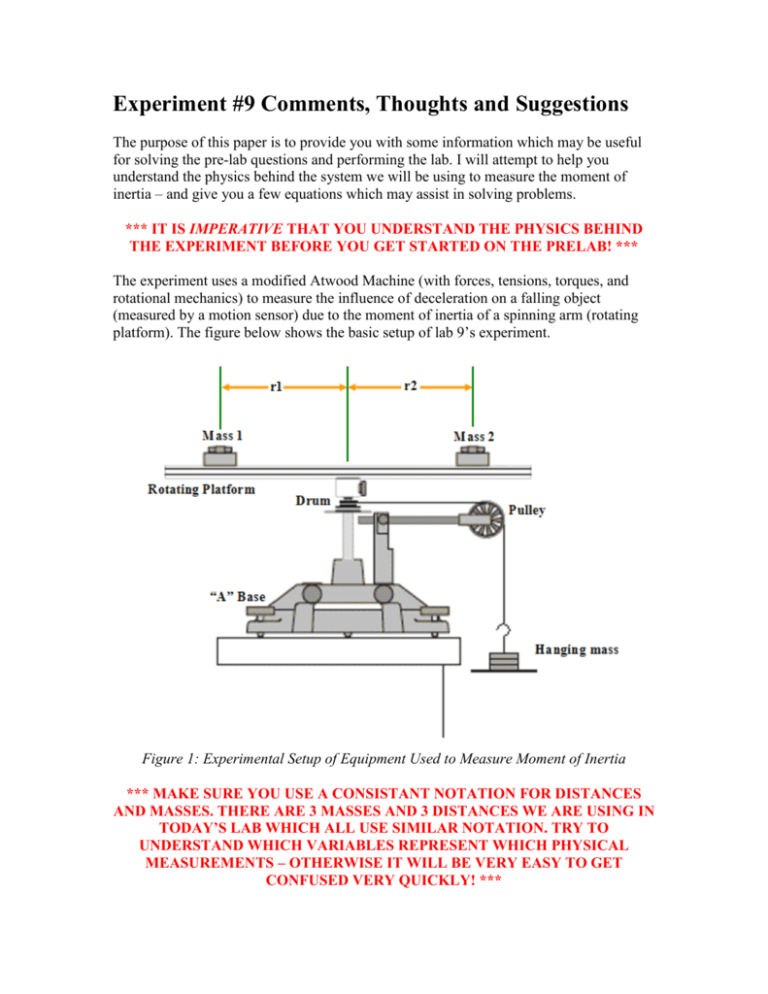
Experiment #9 Comments, Thoughts and Suggestions The purpose of this paper is to provide you with some information which may be useful for solving the pre-lab questions and performing the lab. I will attempt to help you understand the physics behind the system we will be using to measure the moment of inertia – and give you a few equations which may assist in solving problems. *** IT IS IMPERATIVE THAT YOU UNDERSTAND THE PHYSICS BEHIND THE EXPERIMENT BEFORE YOU GET STARTED ON THE PRELAB! *** The experiment uses a modified Atwood Machine (with forces, tensions, torques, and rotational mechanics) to measure the influence of deceleration on a falling object (measured by a motion sensor) due to the moment of inertia of a spinning arm (rotating platform). The figure below shows the basic setup of lab 9’s experiment. Figure 1: Experimental Setup of Equipment Used to Measure Moment of Inertia *** MAKE SURE YOU USE A CONSISTANT NOTATION FOR DISTANCES AND MASSES. THERE ARE 3 MASSES AND 3 DISTANCES WE ARE USING IN TODAY’S LAB WHICH ALL USE SIMILAR NOTATION. TRY TO UNDERSTAND WHICH VARIABLES REPRESENT WHICH PHYSICAL MEASUREMENTS – OTHERWISE IT WILL BE VERY EASY TO GET CONFUSED VERY QUICKLY! *** As usual (since otherwise it would be too hard), we will assume the mass of the string is negligible (massless string) and the friction on the pulley is nearly zero (frictionless pulley). We should first attempt to use Newton’s Laws to determine if this system is capable of any analysis. If we first determine the forces established in the system due to the hanging mass we can effectively find the tension in the string and the force (tension) acting at the rotating drum located under (and attached to) the rotating platform. The following figure shows the forces acting in the system due strictly to the hanging mass. Figure 2: Diagram Showing the Forces/Tensions in Play in the System Notice that there is a tension force in the string directly at the drum. This will cause a torque at the point where the string touches the drum. The following figures provide a close up of the string in contact with the drum. Since the force is operating [see the top picture – figure 3] at a distance away (one radius to be exact) from the center or the drum [see the middle picture – figure 4], there will be a torque created [see the bottom picture – figure 5] – making the drum want to spin (unwind) counter-clockwise (per the right-hand rule, since the torque vector is pointing up). ** WARNING: DO NOT GET TOO CLOSE TO THE ROTATING ARM IN REAL LIFE. IT WILL SPIN UNDER THE INFLUENCE OF THE TORQUE AND COULD POTENTIALLY CAUSE SEVERE INJURY DUE TO ITS ROTATIONAL VELOCITY AND SHARP EDGES!!!! *** (P.S. The previous warning is serious … not a joke.) Figure 3: Top-Down Isometric View of the Force (tension in the string), Acting at the Point where the String Leaves the Drum Figure 4: Top-Down Isometric View of the Radius (and diameter) of the Drum at the Point where the String Leaves the Drum Figure 5: Top-Down Isometric View of the Torque (explicitly its direction and the rotation created by this torque) Created by the Force (Tension) in the String, Operating at a Radius from the Center of the Drum When performing the experiment, it will be necessary to accurately measure and record the radius of the drum attached to the rotating arm. We will use calipers, and measure the diameter of the drum and then use mathematics to calculate the radius. r d 2 Figure 6: Side view of the Drum, Explicitly Showing the Measured Radius of the Drum Now that the setup and variables are defined for the experiment, we can do some physics to determine the equation for the Moment of Inertia of the rotating arm with the masses attached. Since we know we have a torque operating (per the discussion and figures above) it will be useful to use that as a starting point for the analysis of the mechanics of this system. The vector equation for torque is given as: r F [Notice for sake of clarity we will use the Greek letter “Tao” for torque and the English capital letter “T” for tensions in all our equations and figures.] Let us re-write the vector equation for the torque using its magnitudes and the definition of the cross-product. r F rF sin (Note: Theta is the angle between the radius vector and the force (tension) vector [in the picture above you can see this is always 90-deg].) Plugging in the static value of theta, the torque equation for this system reduces simply to: rF sin 90 o rF 1 rF (eq. 1) The force (according to Newton’s 3rd Law) is the tension in the string due to the hanging mass of the dynamic system. F T (tension ) (eq. 2) By definition, Newton’s second law in rotational form (torques) can be looked up in a book and written as: a r I I (eq. 3) Notice that we used the relationship between linear acceleration and rotational acceleration and solved for the rotational acceleration in terms of the radius of the drum and the linear acceleration of the falling (hanging) mass. If we now combine equations 1, 2 and 3 above, we can get the following relationship for torque: Tr Tr Ia r Ia (eq. 4) r Recall from lab 4 and 5 (specifically the pre-labs) we performed an analysis of a dynamic system for an Atwood Machine using Newton’s Laws (it may be useful to go back and look at the free-body diagrams drawn and process used to find the Tension in the string). ** MAKE SURE YOU KEEP THE DIRECTIONS STRAIGHT – SO YOU DON’T MISS A NEGATIVE SIGN!!! *** Figure 7: Free Body Diagram of the Hanging Mass Using Newton’s Laws for a dynamic system, the free body diagram for the system above gives the following: T mg ma or T mg ma If we now solve for the Tension and substitute this is for the Tension in equation 4, we get the following: Ia mg ma r r Finally, solve for the Moment of Inertia, and simplify the equation. I mg mar 2 a mg a r 2 mr 2 g a 2 g mr 1 a a a g I mr 2 1 a This means, given the mass of the hanging mass, the radius of the drum, the acceleration due to gravity and the measured acceleration of the falling mass (from a best fit line of position versus time); we can then calculate the moment of inertia for the spinning arm (with zero or more masses attached). Moments of inertia add linerally. That is to say, if we have an object that we have measured its moment of inertia – and then add additional objects to the original object, the total moment of inertia will be the net sum of the original moment of inertia plus the moment of inertia contributed by each of the individual added masses. Mathematically this is given as: n I Total I j j 0 In today’s lab, we will measure the moment of inertia of the apparatus with no masses attached. We will then add two additional masses at various distances from the rotational axis to the system and re-measure the new moment of inertia. We can use the linearity described above to determine the theoretically the expected outcome of the experiment. n I Total I j I o I1 I 2 j 0 Where Io is the moment of inertia of the bar without any masses attached (obtained experimentally with Logger Pro). I1 and I2 is the calculated moments of inertia from mass 1 and mass 2 (respectively). During the execution of the experiment, it will be necessary to measure the distances of the masses from the center rotation point of the rotating arm. This is not a trivial process, since you need to measure from the exact point (unmarked) of the center of rotation to the center (unmarked) of the location of the mass. This is shown in the following figure. Figure 1: Top-Down Isometric View of the Positions of Masses 1 and 2 on the Rotating Arm of the System In attempt to simplify the process for measuring these distances (and making them relatively equal in length), we can use the following process. r1 r2 1 l d 2
